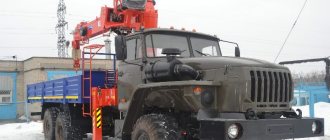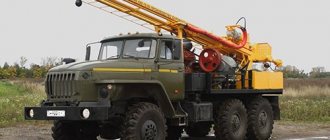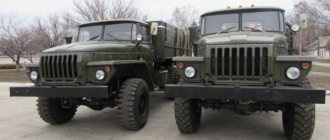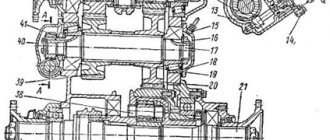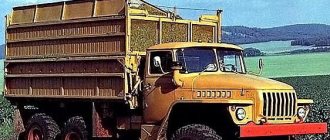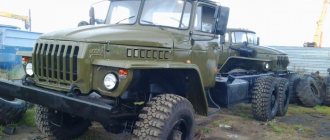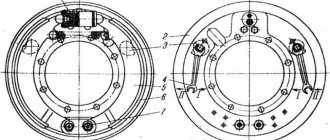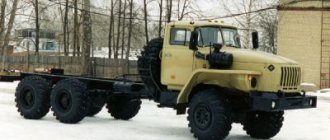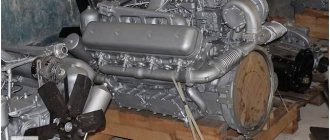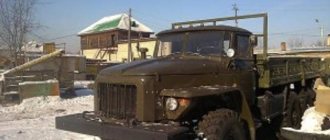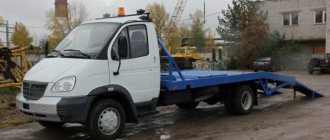Crew buses Ural 1
To quickly and safely deliver working personnel from repair, construction, and geological exploration teams to remote industrial sites, a shift truck based on a Ural truck is used. The bus is a welded van body mounted on a truck chassis and equipped for the comfortable transportation of people. Various modifications of cars are offered, differing in the number of passenger seats and technical characteristics of the transport base. The equipment meets the requirements for reliability, structural strength and the creation of conditions for maintaining an optimal internal microclimate.
Military vehicles Ural-4320
The frame-metal van body with thermal insulation is equipped with double passenger seats for 20 people, with seat belts. On one side, these seats are attached to the wall of the rotation bus, and on the other, to its floor, through a special support leg. This allows you to free up space under the seats for easier and better cleaning of the crew bus interior. The seat cushion is quite wide, the backrests are anatomically shaped and equipped with headrests integrated into them. The seat upholstery is made of frost-resistant artificial leather, it is durable and practical.
Windows, at the request of the customer, can be made of double sealed double glazing of safety glass, with a seal 60 mm thick. All windows in the cabin of the rotation bus are equipped with sun blinds.
The floor of the van is made of bakelized plywood, waterproof, and insulated with high-density polystyrene foam of 30-millimeter thickness. They are also covered with high-strength multilayer polymer coatings that have an anti-slip effect. The cutting of this floor covering is specially designed for as few joints as possible. All its connections to the walls are made without joints - with smooth transitions to the walls, for impeccable waterproofing and ease of cleaning in the cabin.
The insulation of the walls and ceiling of the van is carried out using extruded XPS polystyrene foam with a thickness of 60 mm. When attaching the inner lining to the frame, a 20-mm thick heat insulator is used for better thermal insulation. The interior lining of the cabin is made of automotive PVC plastic, which is not subject to temperature changes and is not afraid of increased air humidity. Any dirt can be removed from such a coating quite easily, and minor mechanical damage will not spoil the appearance of the interior.
The autonomous air heater in the Ural cabin 32551-0010-41 is equipped with 2 independent heating circuits. In cases of failure of the main circuit (from the cooling system of a diesel engine of a car), an additional one is activated, operating in autonomous mode, using diesel fuel. This heater is controlled by an automatic electronic unit located in the cabin of the rotation bus (but it can also be installed in the driver’s cabin).
24-volt voltage is constantly supplied from the vehicle's electrical circuit. The cabin of the rotation bus is equipped with the required number of ceiling dust- and moisture-proof lamps (fluorescent). The car is equipped with a cabin-loudspeaker intercom.
Advantages of a rotation bus
The Ural shift vehicle is in demand by many enterprises and organizations operating at sites remote from infrastructure due to the advantages of the vehicles:
- Ability to operate equipment in a wide temperature range and high humidity conditions.
- Increased cross-country ability on various types of roads and off-road.
- Rugged van design. Convenient entry thanks to the folding ladder.
- Good heat and sound insulation. Practical internal lining, characterized by frost resistance and ease of cleaning from dirt. Moisture-resistant floor with waterproofing effect.
- Increased level of passive safety. When the machine overturns, the frame is not deformed and vital space is preserved.
- Ergonomic and comfortable interior. Double-glazed windows, wear-resistant fittings designed for the entire period of operation. Triple sealant contour for tightness of doors and hatches. Comfortable seats with seat belts.
- Main and additional independent heating circuit.
- An exhaust system designed to prevent exhaust gases from entering.
- High-quality painting that provides reliable protection against corrosion and extends the service life of the shift vehicle.
The frame of the passenger van performs a load-bearing function. It is made from square tube using modern welding equipment. To equip the load-bearing structure of the floor, a reinforced rectangular profile is used. In order to increase rigidity, cross members are additionally welded onto which the decking is mounted. The insulation of walls and ceilings is carried out with expanded polystyrene having a thickness of 60 mm. The Ural rotation bus is designed with a low center of gravity, which is ensured by a low floor. Passengers can move freely around the cabin. To increase comfort, there are no wheel arches inside the van, and the seats are installed at the same level. Convenient loading and unloading of workers is ensured by a low entrance and a folding staircase. There is an emergency exit at the rear. The Ural 4320 shift vehicle and other models (modifications) intended for transporting people are lined with PVC plastic on the inside (ceiling and walls). Laminated paper and glass fiber reinforced plastic are used. When installing the inner lining, a heat insulator is installed, which completely eliminates the formation of cold bridges. High-strength moisture-resistant plywood (S=12 mm) is laid on the floor, under which high-density polystyrene foam is laid. A polymer coating with an anti-slip effect is mounted on top. The outside of the van is lined with high-quality sheet steel. Thanks to this design, good thermal insulation is ensured, designed for the entire operational period of the vehicle. In order to provide heat and sound insulation, the windows of the rotation bus are made of double-glazed windows with increased tightness. Safety glasses with reinforced seals are used. There are vents to provide fresh air access to the cabin. The van is structurally equipped with an emergency exit hatch and a forced ventilation system. Sun shades are installed on all windows. The front side door is equipped with a reliable lock and is made using high-quality insulation. The installed fittings are wear-resistant and are designed for the entire period of operation of the vehicle.
In the passenger compartment of shift vehicles of various modifications, ergonomic anatomically shaped seats with integrated headrests are installed, reducing passenger fatigue. The upholstery is made from durable fabric or practical artificial leather that can withstand temperature changes. The seats are equipped with seat belts. A new, improved system is used to secure the seats, ensuring the safety of transported personnel in emergency situations. Lighting lanterns and entrance lighting are mounted above the passage. Power supply is provided from the vehicle's on-board 24 V network.
For a comfortable trip in winter conditions, the optimal internal microclimate is maintained by heaters with air supply fans. The heat exchangers are connected to the engine cooling system and fixed under the seats. Independent thermal units Webasto Airtop running on diesel fuel are used as an additional heat source. Depending on the modification of the interior, the cars are equipped with heaters of 2.0–5.5 kW. The ergonomics of the cabin are designed to comfortably accommodate employees to overcome long distances without fatigue. All rotation buses are equipped with fire extinguishers and first aid kits installed on brackets in the passenger compartment and in the cabin. To ensure communication with the driver, a special intercom is provided.
Technical characteristics of the Ural-6370 in numbers
The car undergoes life tests in forced mode on different types of roads, among which there are not only asphalt roads, that is, almost only off-road, we will also include cobblestones in it. For a two-axle vehicle, the factory requires different air pressures to be maintained on a hard surface in the tires of the front 3.5 kg cm 2 and rear 5.5 kg cm 2 axles.
Additional options
In order to expand the functionality of the wheelbase, as well as stable operation of the shift vehicle in any climatic conditions, additional options are offered. In order to preserve internal heat, the cabin is insulated with penofol. The material is moisture resistant and not susceptible to mold. Heating the fine and coarse fuel filter allows the pump to create the required fuel pressure in the system. When operating a vehicle in harsh conditions, heating of the fuel line and fuel intake can be installed. In order to maintain the density of the battery, a heating system is installed or the battery is sealed with penofol. The warm package includes heated exterior mirrors and the driver's seat. When purchasing a shift jacket, customers can order:
- Double glazed windshield with heated wipers.
- Insulation of the hood for maximum heat retention of the power unit.
- Strengthening springs on the front axle.
- Connecting an additional fuel tank for long-distance flights away from infrastructure.
- Installation of a mechanical or electric winch, allowing you to overcome any obstacles when driving off roads with improved surfaces.
- Installation of a protective mesh on the headlights and rear lights, necessary when driving in wooded areas.
The anti-corrosion treatment service allows you to protect the underbody and fenders of your car from corrosion. When operating a vehicle in a hot climate, it is possible to order the installation of an air conditioner. In winter, an additional heater is installed to maintain an optimal microclimate in the passenger van and in the cabin. Control over the internal temperature is provided by special sensors. The power of the unit is enough for you to comfortably stay in a car with the engine off for a long time, even in severe frosts.
Braking system: Chassis modifications
The vertical surface of the main bearing is sealed with wooden pads, the horizontal surface of the joint with the crankcase is sealed with an oil-resistant rubber gasket. This article presents the Ural-5323 vehicle, the technical characteristics of which make it possible to successfully solve many problems in the oil and gas, logging, military and civilian fields.
| Ural dump trucks since 2008 | |||
| Model, brand, modification of the car | Engine power, l. With. | Working volume, l | Fuel consumption rate per 100 km |
| 1 | 2 | 3 | 4 |
| URAL-55571(YAMZ-236NE2) | 230 | 11,15 | 43.8D |
| URAL-63685-10 (YAMZ-760.10) | 300 | 11,15 | 43.0D |
Power supply system, fuel consumption: Modifications Ural-43206
| Ural-43206 technical characteristics and overall dimensions, fuel consumption The author expresses gratitude to Anatoly Titkov, Valery Dmitriev, Nikolai Markov, Sergey Orlov, Maxim Shelepenkov, employees of the State Research Center of the Russian Federation Federal State Unitary Enterprise NAMI and the press service of AZ Ural for the assistance provided in the preparation of the article. They differ from each other in the different number of seats for passengers up to 28; low or high van roof level; the presence or absence of an additional cargo compartment; features of the van's internal equipment. |
| Ural 375 technical characteristics, engine and fuel consumption, gearbox and photo of the cabin The price asked for this equipment depends on the technical condition of the particular machine and varies from four hundred thousand rubles to one million four hundred thousand. Despite the high fuel consumption during operation, interest in this equipment remains due to its unique maneuverability and fairly simple maintenance. |
- Body length Ural 4320 – 736.6 cm.
- The width of the Urals is 250 cm.
- Height – 287 cm.
- Wheel base – 352.5 cm.
- Front track – 200 cm.
- Rear track – 200 cm.
- Clearance parameter – 40 cm.
- The smallest turning radius is 1140 cm.
- The curb weight of the URAL is 4320 – 8050 kg.
- The total weight of the URAL 4320 is 15205 kg. This is how much a Ural car weighs in working condition.
Military and basic modifications • For deliveries to countries with tropical climates, the 375DU variant was produced.
Advantages of cooperation with an official dealer
Our showroom provides the opportunity to buy a Ural watch that meets the requirements for technical characteristics, number of passengers and cross-country ability. Vehicles have been certified in accordance with the established procedure and are approved for use for their intended purpose. Shift trucks on the Ural wheelbase provide the opportunity to comfortably transport work crews to remote sites. The vans comply with legal requirements for the safety of transporting people. High-quality components and thermal insulation materials ensure the practicality and efficiency of special vehicles for carrying out personnel transportation tasks. Shift buses are supplied from the manufacturer without additional commissions. Models produced in 2022 are available at an affordable price, including the modernized Ural M shift vehicle. Customers are offered passenger modifications with a cargo compartment, as well as the Ural 4320 shift 92 and Ural Next shift 85. Before purchasing, customers can inspect the vehicle and familiarize themselves with the technical characteristics , equipment, a list of options available for installation, vehicle capabilities, and also test vehicles during a test drive. Qualified mechanics of our car service center carry out conversion of the wheelbase for gas installations and qualified installation of additional equipment that expands the functionality of the shift vehicle. Upon request, modernization and modification of vehicles is carried out. Guaranteed maintenance and repairs are provided using original spare parts. More than 10 thousand items of components are always available. Managers will introduce the technical characteristics and design features of rotation bus models. Clients are guaranteed documentation of the purchase in accordance with the law and qualified legal support of the transaction.
History of creation
By the beginning of the 50s, the Soviet Army had all-terrain vehicles with a carrying capacity of 1 ton (GAZ-67 and the promising GAZ-69), 2 tons (GAZ-63) and 3 tons (ZiS-151 and the ZIL-157, which was in development). To transport heavy equipment, it was necessary to use civilian trucks MAZ-200 and YaAZ-210 with rear drive wheels.
Based on the civilian truck MAZ-200, a modification with all-wheel drive MAZ-502 was created, but the axle load exceeded the permissible limits for all-terrain vehicles. This was the reason for the start of work at the NAMI Institute in 1953 on a promising multi-purpose all-terrain vehicle.
The vehicle being developed with a carrying capacity of 5 tons was supposed to occupy an intermediate position between the ZiS-151 and the KrAZ-214 (a version of the YaAZ-210 with all-wheel drive). The prototype received the designation NAMI-020 and was equipped with a 180 hp gasoline engine. The design used walk-through bridges and pneumatic-hydraulic brakes. After testing, the documentation was transferred to the Ural Automobile Plant.
The first cars were assembled in 1958-59, in parallel with the reconstruction of production facilities at the plant.
Tests of pre-production vehicles were carried out at the end of 1959 and beginning of 1960.
Based on the test results, the design of the all-terrain vehicle underwent minor changes, and already on November 7, 1960, the first production Ural-375 was assembled. The all-terrain vehicle took part in the celebrations dedicated to the anniversary of the October Revolution. Serial production started in January 1961.
The plant produced gasoline versions of cars until 1992. Moreover, since 1977, the main share of production began to be occupied by the Ural-4320 diesel all-terrain vehicle, which quickly replaced vehicles of the 375 family from army combat units. In total, at least 110 thousand Ural-375 vehicles of various modifications were produced.
Technical specifications in numbers
The interior decoration and cladding have modern materials that provide good noise and heat insulation, and a steering wheel with lower spokes does not overlap the instruments. For the same reason, before the brief technical characteristics of the car, we provide an excerpt from the technical specifications for the URAL -43206-0111-41 car, which talks about operating conditions.
Exterior: Chassis modifications
Unlike similar crew buses of previous years, here the manufacturer has found the opportunity to lower the floor in the aisle, and passengers can move between the seats at full height, and entering the cabin is more convenient than before. Overall dimensions length 7.740 m standard, 7.965 m extended version; width 2,550 along the bumper; 3,092 on the side mirrors; height 3.358 m.
| Parameter | "Ural-375"D | "Ural-375" SK1 | "Ural-375"N |
| Load capacity, kg | 5000 (when installing a winch - 4500) | 5500 | 7000 (when installing a winch - 5000) |
| Trailer weight on the ground, kg | 5000 | 12000 | 7000 |
| Trailer weight on the highway, kg | 10000 | — | 10000 |
| Fuel consumption, l/100 km | 46 | 57 | 46 |
| Speed, km/h | 75 | 65 | 75 |
| Length, mm | 7366 | 6986 | 7611 |
| Width, mm | 2674 | 2500 | 2500 |
| Height, mm | 2980 | 2680 | 2600 |
Modifications of Ural-375 Modifications of the model
| Ural 375: technical characteristics (performance characteristics), fuel consumption per 100 km, how the legendary car was tested. At the customer’s request, the car can be painted in corporate colors, company logos can be applied, the bus interior can be equipped with air conditioning, and the cabin can be insulated with penofol. deterioration in controllability, usually the safety valve pump seat comes loose, you will need to disassemble the pump and screw the seat to the desired position. |
- red warning light for low oil pressure;
- light switch;
- red lamp for minimum tire pressure;
- a red lamp indicating an emergency condition of the brake system;
- cabin light switch;
- egnition lock;
- switches for the ventilation system and turning lights.
Other models URAL-4320
A typical car chassis allows it to be used as a basis for creating equipment to solve specific specific problems. For example, tanks are installed on it for transporting water, fuel, and petroleum products. There are options for the URAL-4320 in the form of a dump truck, tractors for transporting pipes, well drilling rigs, cranes, lifts, and so on. Sometimes houses for people to live in are installed on the car chassis, turning the URAL-4320 into a kind of transportable cabin. In fact, a car with minimal modifications due to its versatility will allow it to be used for any purpose, regardless of conditions.
| Dimensions | ||
| Wheelbase, mm | 3525 + 1400 | |
| Length, mm | 7143 | |
| Width, mm | 2500 | |
| Height, mm | 2740 | |
| Outer turning radius, m | 11,6 | |
| Weight characteristics | ||
| Load on SSU, kg | 8100 (7600**)* / 5500 | |
| Distribution of the total weight of the Ural truck tractor, kg | to the front axle | 5005 (4975**) |
| on the rear trolley | 11715 (11245**) | |
| Distribution of curb weight of truck tractor, kg | to the front axle | 4570 |
| on the rear trolley | 3750 | |
| Permissible total weight of the road train, kg | 27720 (30620**)* / 21120 | |
| Weight of towed semi-trailer, kg | 19100 (22000**)* / 12500 | |
| Engine | ||
| Engine | YaMZ-238M2 | |
| Rated engine power, kW (hp) | 176 (240) | |
| Maximum torque, Nm (kgfm) | 883 (90) | |
| Engine displacement, l | 14,86 | |
| engine's type | diesel | |
| Number and arrangement of cylinders | V8 | |
| Environmental Compliance | Euro 0 | |
| Suspension | ||
| Front suspension | dependent on two longitudinal semi-elliptical springs, working in conjunction with double-acting hydraulic telescopic shock absorbers | |
| Rear suspension | dependent on two semi-elliptic springs and suspensions, working in conjunction with double-acting hydraulic telescopic shock absorbers | |
| Transmission | ||
| Transmission | YaMZ-236U, mechanical, 5 speed. | |
| Transfer case | mechanical, two-stage with lockable center differential | |
| Tires | ||
| Tire size | 1200×500-508 mod. ID-P284 or 390/95R20 147J mod. O-65 or 12.00R20 mod. U-4.12.00R20 mod. U-4,ID-304 | |
| General characteristics | ||
| Cabin | 2-door | |
| Number of seats in the cabin, including the driver's seat | 3 | |
| On-board power supply voltage, V | 24 | |
| Fuel tank capacity, l | 300 | |
| Wheel formula | 6×6.1 | |
| Fuel consumption | ||
| Control fuel consumption at a speed of 60 km/h, l/100 km | 46 | |
| Speed | ||
| Maximum speed at full vehicle weight, km/h | at I main gear = 6.7 | 75 |
| at I main gear = 7.32 | 70 |
- * when used on roads of categories 1-4.
- ** when used with a semi-trailer mod. 9516.
- Height dimensions are indicated for the vehicle with curb weight in transport position.
- Overall width does not include rear view mirrors.
- The control fuel consumption is not an operating norm.
- Since December 1, 2002, JSC Avtomobilny has been producing cars and chassis with engines that meet environmental standards no lower than Euro I, except for cars and chassis intended for delivery to the Ministry of Defense.
Rotational bus Ural 32551-0013-61M
Purpose of the rotation bus Ural 32551-0013-61
The Ural 32551-0013-61 rotational bus is designed for all-season delivery of rotational and repair crews to work sites of up to 22 people, including 2 people in the vehicle cabin.
Chassis of the rotation bus Ural 32551-0013-61
The vehicle's chassis is all-wheel drive, with a 6x6 wheel arrangement, OI-25 (14.00R20) all-terrain tires, and a pneumatic braking system with an ABS anti-lock braking system. The power unit of the Yaroslavl Motor Plant YaMZ-65654 is diesel, V-shaped, 230 hp, with a single-disc clutch. Gearbox – mechanical, five-speed.
Body of the rotation bus Ural 32551-0013-61
The body structure of Ural 32551-0013-61 is made in the form of a metal van with thermal and sound insulation, windows and an entrance door located on the right side. The bus interior is equipped with double anatomical seats with seat belts. The windows are double glazed; there are ventilation hatches on the roof of the cabin, which can be used as emergency exits if necessary. Heating of the cabin is provided by two heaters with a heat extraction system from the engine, as well as one autonomous heater OV-65. For negotiations between the cabin and the salon there is an intercom.
| Engine YaMZ 65654 | |
| engine's type | Four stroke diesel |
| Number and arrangement of cylinders | 6, V-shaped |
| Cylinder displacement, cm3 | 11150 |
| Compression ratio | 17,5 |
| Maximum power, kW | 169.2 (230 hp) |
| Maximum torque, N*m | 883 |
| Fuel | Diesel |
| General characteristics of the rotation bus Ural 32551-0013-61 | |
| Basic chassis | Ural-4320 |
| Wheel formula | 6x6 |
| Weight of the equipped vehicle, kg | 11000 |
| Gross vehicle weight, kg | 12570 |
| Number of seats | 20 + 2 in cabin |
| Maximum speed, km/h | 85 |
| Fuel tank capacity, l | 230 |
| Overall dimensions, mm | 8930 x 2500 x 3615 |
| Load distribution of the equipped vehicle, kg | |
| To the front axle | 4200 |
| On the rear trolley | 6800 |
| Load distribution of vehicle total weight, kg | |
| To the front axle | 4270 |
| On the rear trolley | 8300 |
| Cabin | |
| Cabin type | all-metal three-seater equipped with increased thermal and noise insulation, a ventilation and heating system, and an adjustable driver's seat |
| Suspension | |
| Front | dependent, spring, with hydraulic shock absorbers |
| Rear | dependent, balanced, with reaction rods |
| Transmission | |
| Transmission | manual five-speed |
| Transfer case | Mechanical two-stage with locked center differential |
| Clutch | |
| Type | friction single-disc |
| Cardan transmission | |
| Type | Open with hinges on needle bearings |
| Steering | |
| Type | With double-acting hydraulic booster |
| Brake system | |
| Working | Drum type with pneumohydraulic drive |
| Auxiliary | Motor type retarder |
| Parking | Drum type brake mechanism |
| Tires | |
| Tire type | 14.00-20 OI-25 with adjustable pressure |
Purpose
The result of this work was the appearance three years later of an experimental 5-ton NAMI-020 6x6 truck with a 180-horsepower V8 gasoline engine of an innovative design, with power steering, all single wheels and a centralized system for regulating tire pressure on the move. Federal 42590 armored car with 5th cabin protection class and a 6 6A protection class kung-armored module for use in special units of the Ministry of Internal Affairs of the Russian Federation;
Cabin Ural-43206: review © Modifications Ural-43206
| Ural 5323: technical characteristics of the long-distance truck, fuel consumption | The production of a new series of trucks, designated Ural-4320, with diesel engines, was gradually increased, while the production of the gasoline Ural-375, on the contrary, was curtailed. The predecessors of the Ural-375 vehicles in the plant’s model range were the UralZIS-355 and UralZIS-355M trucks, produced by the company from the late 40s to 1965. |
| Rotational bus Ural 3255-3013-79E5-28 Titkov The car with a gasoline engine had a load on the front axle of 4.5 tons, and the car could freely climb the stairs, and the steps were almost half a meter high. The lifting height of the load with the main boom of such a crane is a little over 30 meters, depending on the modification; there is a slight variation in this value; when using an additional jib for a little over 40 meters. |
- Overall dimensions: length – 7.740 m (standard), 7.965 m (extended version); width – 2,550 (along the bumper); 3,092 (based on side rear view mirrors); height – 3.358 m.
- External overall turning radius – no more than 13 m (standard), 15.5 (extended base).
- The load capacity of the dump truck is 19.5 tons.
- Maximum weight of cargo placed on the chassis: 23,010 tons (standard base) and 22,460 tons (extended base); The maximum weight of a semi-trailer for a tractor-trailer attributable to the fifth-wheel coupling device is 22 tons.
- Weight of the equipped vehicle: dump truck, chassis - 10...10.5 tons; truck tractor – 12 tons.
- The maximum gross vehicle weight, in any modification, is up to 34.5 tons.
- Gross weight distribution: dump truck - front axle: 8.485 t; rear bogie: 25,950 t; chassis and truck tractor - front axle: 7.5 t; on the rear bogie: 26 t.
- Maximum gross weight of towed trailer (semi-trailer): 42.5 t – chassis and dump truck; 64.675 t – truck tractor.
- The total weight of the road train is 76 tons.
- Maximum speed – 80 km/h.
- Fuel tank capacity – 500 liters.
- Diesel fuel consumption is from 52 liters per 100 kilometers.
Specifications
To ensure smooth delivery of working personnel to remote sites, vans are mounted on basic off-road chassis. Customers are offered the following modifications of Ural rotation buses:
- 3255-0013-61. Designed for 28 seats. Wheel formula 6x6. A YaMZ engine is installed, developing 228 hp.
- 5557-4512-82, cabover (6x6) for 20 passenger seats. Equipped with a powerful YaMZ engine producing 310 hp. and technological transmission ZF-9S1310T0. There is a sleeping compartment for the driver.
- NEXT 3255-5013-71, equipped with 6x6 all-wheel drive. The cabin is designed to safely transport 28 passengers. The power unit produces 238 hp. and works with the YaMZ-1105 transmission.
- NEXT 32551-5013-71, equipped to transport 20 workers. A 240 hp engine, 6x6 all-wheel drive and a YaMZ-1105 manual transmission are installed. The car has a modern appearance.
- 4320-6951-72 with a 6x6 wheel arrangement for confident off-road driving. Designed for 28 seats. The bus is equipped with a YaMZ engine with a power of 273 hp.
- 4320-4971-80 all-wheel drive (6x6) cabover with 273 hp engine. is equipped with a cabin designed for 28 seats. The car is equipped with a sleeping compartment for the driver.
- A rotation bus designed to transport 22 workers on roads of any quality. Built on the base chassis Ural-43206-41. Wheel formula 4x4.
For transport support of mineral deposits, logging and facilities located at a distance from improved roads, cargo-passenger shifts are in demand. Special vehicles differ from standard models in having a shortened passenger compartment and a cargo compartment (open area) without lifting equipment. Such vehicles are designed to transport 10–15 workers, as well as equipment and necessary tools to the place of work. As an option, it is possible to order a hydraulic manipulator, which allows you to autonomously perform loading and unloading operations. The passenger compartment is equipped similarly to vans installed on other modifications of the Urals. Autonomous heating, additional fuel tanks, audio, video equipment, etc. are provided. Cargo platforms can be equipped with removable sides, awnings to protect the cargo, and special boxes for tools and special equipment. Shift buses are equipped with a modern braking system with pneumatic drive. Cars on the highway reach a maximum speed (depending on the model) of up to 100 km/h. Average fuel consumption is at the level of 35–40 liters. When operating in hot climates, an air conditioner is installed to cool the air inside the cabin. For a reliable start of the power unit in low temperature conditions, a pre-heater is installed in the engine compartment. Shift bikes mounted on an all-terrain wheeled chassis are supplied in the following configuration:
- The spare wheel is secured on the rear wall of the passenger van.
- Low floor layout in the center of the cabin for easy passenger movement.
- Three-point seat belts for all seats.
- A tachograph that records speed limits and driver rest intervals.
- Pneumatic actuator for activating low gear of the transfer case.
- Pneumatic drive of the hand brake system.
- Blocking of interwheel and center differential.
- Anti-lock braking system.
The basic chassis can be equipped with electric windows and central locking. New cabins are installed on rubber-metal hinges with an expanded doorway. The drive axles and transfer case of the new base chassis models are designed to transmit 50% more torque, which has a positive effect on the cross-country ability of vehicles. The service life of the cardan transmission has also been increased. Power steering is used, allowing the driver to apply minimal effort to maneuver a multi-ton truck. Special requirements are placed on the chassis of a vehicle equipped for transporting people. The modernized frame is characterized by increased rigidity thanks to the installation of a one-piece reinforcement. To prevent the formation of rust spots, the chassis is treated with an anti-corrosion compound.
